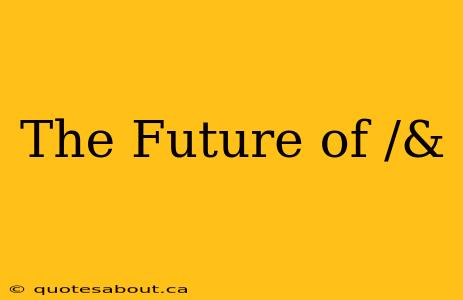The Future of & (Ampersand)
The ampersand (&), a charming glyph representing "and," holds a unique position in the digital landscape. While its practical usage might seem limited in the age of ubiquitous keyboards and spell-checkers, its future isn't necessarily one of obsolescence. Instead, the ampersand's future lies in a nuanced blend of practicality, aesthetics, and symbolic representation.
Will the ampersand disappear completely?
No, the ampersand is unlikely to disappear completely. While its core function—representing "and"—is easily replicated with the word itself, the ampersand's enduring appeal stems from its visual and symbolic qualities. Its continued use in branding, design, and even casual writing demonstrates a persistent cultural significance.
Is the ampersand still relevant in modern writing?
Its relevance is shifting. While it's not commonly used in formal writing, its use persists in informal contexts and stylistic choices. It's frequently employed in logos, company names (e.g., & Other Stories), and social media handles to create a visually appealing and memorable brand identity. The ampersand's concise nature and stylistic flair make it a compelling alternative to the word "and" in specific situations.
What are the advantages and disadvantages of using an ampersand?
Advantages:
- Visual Appeal: The ampersand is aesthetically pleasing and adds a touch of elegance or informality to text. It can create a more concise and visually appealing design, particularly in logos and branding.
- Brand Identity: Companies leverage the ampersand to create a unique and memorable brand identity, setting themselves apart from competitors.
- Space Saving: In limited spaces, such as social media handles or logos, it offers a more concise representation of "and."
Disadvantages:
- Accessibility: Not all fonts render the ampersand consistently, potentially creating readability issues.
- Misinterpretation: In formal settings, its use might be perceived as unprofessional or overly casual.
- Potential for Confusion: If used excessively or improperly, it can lead to confusion or ambiguity.
What is the ampersand's role in branding and design?
The ampersand plays a significant role in branding and design. Its unique shape and historical significance make it a powerful symbol, often used to convey a sense of tradition, sophistication, or a connection between different elements. Many brands integrate the ampersand into their logos or names to create a memorable and visually appealing brand identity, associating themselves with a sense of heritage or craftsmanship. This use isn't likely to diminish.
How is the ampersand used in different contexts?
The ampersand's usage varies across different contexts:
- Informal Writing: Used in casual settings, blog posts, or social media to add a stylistic touch.
- Branding and Logos: Frequently integrated into company names and logos to create a visually striking and memorable brand identity.
- Legal and Formal Documents: Generally avoided due to potential ambiguities and the preference for formal language.
- Social Media: Often used in usernames or handles to enhance visual appeal and create a concise representation of "and."
The Future is Stylistic
The ampersand's future doesn't hinge on its replacement by the word "and." Instead, its continued relevance lies in its aesthetic value and symbolic function. As designers and brands continue to seek unique ways to express their identity, the ampersand will likely retain its place as a stylish and memorable element in various visual and written communication forms. Its continued existence will be based on its ability to enhance visual communication, not its functional replacement of the word "and."

